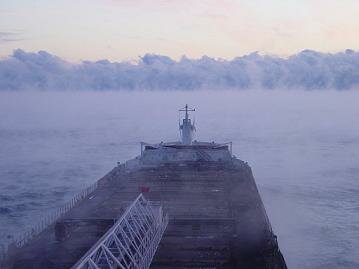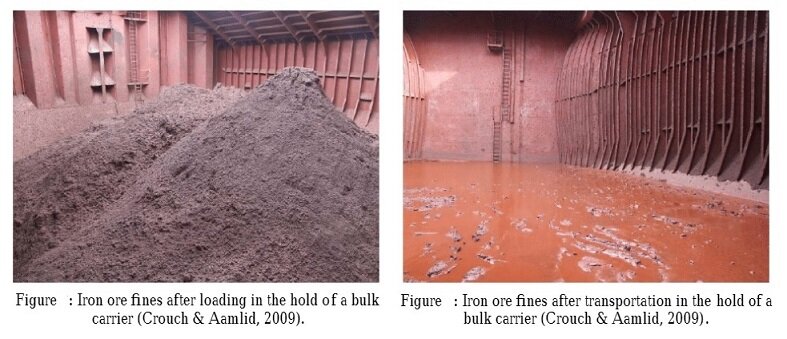
Fig:Bulk carrier American Mariner at sea
Sinter feed is clearly listed in the IMSBC Code as Iron Concentrate, under the schedule for Mineral Concentrates. All cargoes covered by this schedule are Group A cargoes and are prone to liquefaction.
Due to vibration and compaction of cargo within the ship, even apparently dry cargoes may liquefy into a semi-fluid state. A liquefied cargo can flow with the ship's roll but, when the ship rolls back, it does not completely return to its original stowage space. This may result in reduced stability and damage to the structure.
SOLAS Chapter VI Regulation 6 states that:
"Concentrates or other cargoes which may liquefy shall only be accepted for loading when the actual moisture content of the cargo is less than its transportable moisture limit. However, such concentrates and other cargoes may be accepted for loading even when their moisture content exceeds the above limit, provided that safety arrangements are to the satisfaction of the Administration..."
IMSBC Code Group A cargoes are susceptible to liquefaction during a voyage even if they are trimmed. Compaction of the cargo can reduce the space between the cargo particles and increase the water pressure. The water rises to the surface, at the same time reducing the friction between the particles and generating a free flow state. This free flow state does not develop if:
- The cargo contains small enough particles that restrict the movement of cargo by cohesion
- the cargo particles are large enough to allow free passage of water between empty spaces between the particles
- the moisture content is so low that even compaction does not cause a flow of liquid.
Problem with Mill Scale
Mill Scale, a by product of hot rolled steel-making, is a bulk commodity liable to liquefaction, like iron ore fines. Mill Scale and Mill Scale Fines possess a transportable moisture limit (TML) and have thus been confirmed as Group A cargoes, which should not be accepted for loading without the shipper having certified the moisture content and TML. Due to the high density of the cargo, the IMSBC Code requires that it should be trimmed flat for the voyage, distributing the weight evenly over the tank top - wet base cargoes are prone to shifting, as the bottom liquefies and the top of the stow becomes free to slide over the base.
Cargo liquefaction cases resulting in total loss
The recent tragic loss of the 2005-built Vietnamese bulk carrier and 22 of its crewship, which was reportedly carrying a cargo of nickel ore from Morowali, Indonesia to China, sank on 25 December 2010 underlines the urgent need for greater enforcement of regulations and testing of cargoes that may liquefy.
In December 2010, following the loss of three bulk carriers and 44 crewmembers in short succession, all owing to cargo liquefaction, the industry was reminded of the dangers associated with the carriage of hazardous cargoes, however, the recent loss demonstrates that the message has still not got through. Shippers and cargo interests have been called upon to conduct an urgent review into the testing and safety processes involved in shipping of hazardous cargoes following the spate of accidents and fatalities in 2010.
Some shipowners reportedly still do not have the relevant experience or knowledge in interpreting the IMSBC Code and are accepting cargoes, which are unsafe. The industry needs reassurances of the competent authorities in the exporting countries that their procedures and processes have integrity and transparency as they are the key to ensuring that seafarer's lives are not put in danger.
At the 16th Session of IMO's Sub-Committee on Dangerous Goods, Solid Cargoes and Containers (DSC) in September 2011, industry associations worked together to help strengthen and clarify the requirements of the IMSBC Code for accurate information relating to the carriage of cargoes that may liquefy, such as nickel ore.
INTERCARGO Issues Nickel Ore Guidance
The International Association of Dry Cargo Shipowners, INTERCARGO has issued a formal guidance document, which aims to guide and inform Shipowners, Masters and other industry stakeholders regarding the particular risks associated with carrying Nickel Ore. In response to the loss of four Bulk carrying vessels and 66 seafarers in little under 12 months INTERCARGO has sought to highlight the potential dangers of carrying Nickel Ore cargoes.
The guide gives practical advice to shippers, shipowners and charterers. The guide also points to other areas of assistance including from a vessel's P&I Club. The Club would like to remind Members of its own extensive information regarding the carriage of Group A cargoes and especially those regarding Nickel Ore in particular. (Source: UK |P&I |CLUB)
Problems of non-compliance with IMSBC code
In the wake of some tragic accidents occurring in the last quarter of 2010 in spite of the fact that the IMSBC Code containing measures to be adopted aimed at preventing the liquefying of bulk cargoes that affect the ship stability becoming mandatory, the concerns continue in the face of non-compliance by some shippers and ship operators.
The dangers that high-density liquefied bulk material poses on ship safety include increased structural load due to movement of the cargo and the rather dramatic effect on ship stability. Though the structural problem remains a serious issue requiring attention, the stability related issues also needs consideration.
Related info:
Our detail pages illustrated many safety aspects of Bulk carrier
Home page |||Bulk carrier types ||| Handling of bulk coal |||Cargo planning ||| Carriage of grain |||Risk of iron ores |||Self unloading bulk carriers |||Care of cargo & vessel |||Cargoes that may liquefy |||Suitability of ships |||Terminal guideline |||Hold cleaning |||Cargo cranes |||Ballast handling procedure |||Bulk carrier safety |||Fire fighting systems |||Bulk carrier General arrangement

Operation of sea going bulk carriers involved numerous hazards . Careful planning and exercising due caution for all critical shipboard matters are important . This site is a quick reference to international shipping community with guidance and information on the loading and discharging of modern bulk carriers so as to remain within the limitations as specified by the classification society.
It is vital to reduce the likelihood of over-stressing the ship's structure and also complying with all essential safety measures for a safe passage at sea. Our detail pages contain various bulk carrier related topics that might be useful for people working on board and those who working ashore in the terminal. For any remarks please
Contact us
Copyright © 2010 bulkcarrierguide.com All rights reserved.
Although every effort have been taken to improve the accuracy of content provided the publisher of this website cannot take responsibility for errors. Disclaimer Privacy policy Home page



